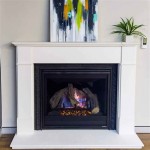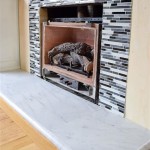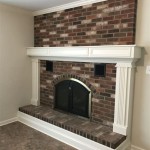How To Clean Glass On a Gas Fireplace
Maintaining a gas fireplace not only enhances its aesthetic appeal but also ensures its optimal performance and longevity. A key aspect of this maintenance involves regularly cleaning the glass panel, which can become obscured by soot and residue from the combustion process. This accumulation can significantly diminish the viewing experience and potentially impact the fireplace's efficiency. Understanding the proper techniques and materials for cleaning the glass is crucial for homeowners to ensure the safe and effective operation of their gas fireplace.
The accumulation of soot and residue on the glass of a gas fireplace is a natural byproduct of burning natural gas or propane. Various factors can influence the rate and intensity of this buildup, including the quality of the gas, the fireplace's ventilation, and the air-to-fuel ratio. Regular cleaning prevents this buildup from becoming excessively stubborn and difficult to remove, preserving the fireplace's visual appeal and functionality.
Before initiating the cleaning process, it is imperative to prioritize safety. Ensure the fireplace is completely cool. Attempting to clean a hot glass panel can result in severe burns and potential damage to the glass. Furthermore, gathering the necessary cleaning supplies beforehand streamlines the process and ensures that the appropriate tools are available.
Gathering Necessary Materials and Tools
Effective glass cleaning begins with assembling the appropriate materials and tools. Certain cleaning agents and scrubbing implements are better suited for this task than others. Using the wrong products can cause damage to the glass or the fireplace's surrounding components.
The following items are typically required for cleaning the glass on a gas fireplace:
*Glass Cleaner Specifically Designed for Fireplaces:
Avoid using general household glass cleaners, as they often contain ammonia or other chemicals that can damage the glass or react adversely with the fireplace components. Specialized fireplace glass cleaners are formulated to remove soot and residue effectively without causing harm. *Soft Cloths or Microfiber Towels:
These cloths are essential for applying the cleaner and wiping away the grime. Microfiber towels are particularly effective at lifting away residue without leaving streaks or lint. Avoid using abrasive materials such as paper towels, which can scratch the glass surface. *Spray Bottle (if the cleaner is not in a spray bottle):
Transferring the cleaner into a spray bottle allows for even distribution on the glass surface. *Scrub Brush or Pad (Non-Abrasive):
For stubborn stains, a non-abrasive scrub brush or pad can be used to gently loosen the residue. Ensure the pad is specifically designed for use on glass surfaces to prevent scratching. *Gloves:
Wearing gloves protects the hands from the cleaning solution and soot residue. *Dust Mask:
A dust mask can help prevent the inhalation of soot particles during the cleaning process. *Vacuum Cleaner with Brush Attachment (Optional):
A vacuum cleaner with a brush attachment can be used to remove loose soot and debris from the fireplace interior before cleaning the glass. *Optional - Baking Soda and Water Paste:
For heavy buildup, a paste made from baking soda and water can be an effective, gentle abrasive.Once all the required materials are gathered, the steps for cleaning the glass can be followed.
Step-by-Step Cleaning Process
Following a structured cleaning process ensures thoroughness and minimizes the risk of damaging the fireplace or injuring oneself. The following steps outline a safe and effective approach to cleaning the glass on a gas fireplace:
Ensure the Fireplace is Cool:
Do not proceed with cleaning until the fireplace has completely cooled down. Typically, allowing several hours after the last use is recommended.Protect the Surrounding Area:
Place a drop cloth or towel around the base of the fireplace to protect the flooring from drips or spills of the cleaning solution.Remove Loose Debris:
Use a vacuum cleaner with a brush attachment to remove any loose soot, ash, or debris from the inside of the fireplace and around the glass. This step prevents the debris from smearing when the glass is cleaned.Apply the Glass Cleaner:
Spray the specialized fireplace glass cleaner evenly onto the glass surface. Ensure the entire area is covered, focusing on areas with heavy soot buildup. Allow the cleaner to sit for a few minutes to loosen the grime. Refer to the cleaner's instructions for the recommended dwell time.Scrub the Glass (if necessary):
If the soot buildup is stubborn, use a non-abrasive scrub brush or pad to gently scrub the glass. Apply gentle pressure and move in circular motions to loosen the residue. Avoid excessive force, which can scratch the glass. For particularly difficult buildup, consider using the baking soda and water paste, applying it with a soft cloth and gently rubbing the affected areas.Wipe Clean with a Soft Cloth:
Use a clean, soft cloth or microfiber towel to wipe away the cleaner and loosened residue. Start from the top and work your way down, overlapping each swipe slightly. Use a clean section of the cloth for each pass to prevent smearing the grime.Buff the Glass:
Once the glass is clean, use a dry, clean microfiber towel to buff the surface, removing any streaks or remaining residue. This step will leave the glass sparkling and clear.Inspect and Repeat (if necessary):
Inspect the glass for any remaining soot or residue. If necessary, repeat steps 4 through 7 to remove any stubborn areas.Clean the Fireplace Interior (Optional):
While cleaning the glass, consider cleaning the interior of the fireplace, including the logs and burner. Use a soft brush or vacuum cleaner to remove any loose debris. Refer to the fireplace manufacturer's instructions for specific cleaning recommendations.Dispose of Cleaning Materials:
Dispose of used cloths, gloves, and any other disposable cleaning materials properly.
Following these steps ensures a thorough and effective cleaning process.
Preventative Measures and Best Practices
Regular cleaning is crucial, but preventative measures can minimize the frequency and intensity of soot buildup. Adopting best practices for fireplace operation and maintenance can significantly extend the time between cleanings and preserve the fireplace's overall condition.
*Ensure Proper Ventilation:
Proper ventilation is essential for efficient combustion and minimizing soot buildup. Ensure that the fireplace's vents and airways are clear of obstructions. If the fireplace has a damper, ensure it is fully open during operation. *Use the Correct Fuel Type:
Using the correct fuel type, whether natural gas or propane, is crucial for optimal performance and minimizing soot. Consult the fireplace manufacturer's instructions for the recommended fuel type. *Regular Fireplace Inspections:
Schedule regular inspections by a qualified technician to ensure the fireplace is operating safely and efficiently. A technician can identify potential issues that may contribute to excessive soot buildup, such as burner problems or ventilation issues. *Burn the Fireplace at the Correct Setting:
Operate the fireplace at the manufacturer's recommended setting. Burning the fireplace at a setting that is too low or too high can lead to incomplete combustion and increased soot production. *Clean the Glass Regularly:
Establish a regular cleaning schedule, such as cleaning the glass every few weeks or months, depending on usage. Regular cleaning prevents soot from becoming heavily baked onto the glass, making it easier to remove. *Proper Log Placement:
Ensure the logs are placed according to the manufacturer's instructions. Improper log placement can obstruct airflow and lead to incomplete combustion. *Annual Professional Maintenance:
Schedule an annual professional maintenance checkup. A qualified technician can clean the burner, inspect the gas lines, and ensure all components are functioning correctly. *Use a Fireplace Blower (Optional):
A fireplace blower can help circulate the heat more efficiently and prevent localized overheating, which can contribute to soot buildup.By following these preventative measures and best practices, the homeowner can reduce the frequency of cleaning and maintain the gas fireplace's optimal performance.
Cleaning the glass on a gas fireplace is a straightforward process when performed correctly. By gathering the necessary materials, following a step-by-step cleaning procedure, and adopting preventative measures, homeowners can maintain the aesthetic appeal and operational efficiency of their gas fireplaces. Regular maintenance not only enhances the viewing experience but also contributes to the longevity and safe operation of the appliance.

Cleaning The Inside Of Gas Fireplace Glass Thrifty Decor Diy And Organizing

How To Clean The Glass On Your Gas Fireplace

How To Clean Gas Fireplace Glass

How To Clean The Glass On Your Gas Fireplace

How Do I Clean My Fireplace Glass Center Kc

Do Gas Fireplaces Need To Be Cleaned Direct Learning Center

How To Remove Clean The Glass On My Gas Fireplace

How To Clean The Glass On Your Gas Fireplace

How To Clean The Glass On A Kozy Heat Gas Fireplace Tophat Pro

How To Clean Fireplace Glass Wood And Gas Fireplaces Anita S Housekeeping
Related Posts








